Evaluating the Trade Union Act 2016's Impact on Employment Relations
VerifiedAdded on 2023/03/17
|12
|3561
|42
Report
AI Summary
This report provides a comprehensive analysis of the Trade Union Act 2016, evaluating its impact on employment relations and industrial disputes in the United Kingdom. The report explores the incidences and conduct of collective industrial disputes, examining how the Act has altered these dynamics. It delves into the implications of the Act, including the rise of leverage tactics employed by trade unions, and assesses both the positive and negative consequences of the legislation. The report also provides recommendations for the management of employment relations, addressing the challenges posed by industrial disputes and offering strategies for organizations. The analysis considers various factors influencing employee attendance and suggests actions to mitigate related issues. The report also discusses the implications of e-balloting and provisions related to public services. Overall, the report aims to provide a detailed overview of the Act's effects and offer practical insights for managing employment relations effectively.
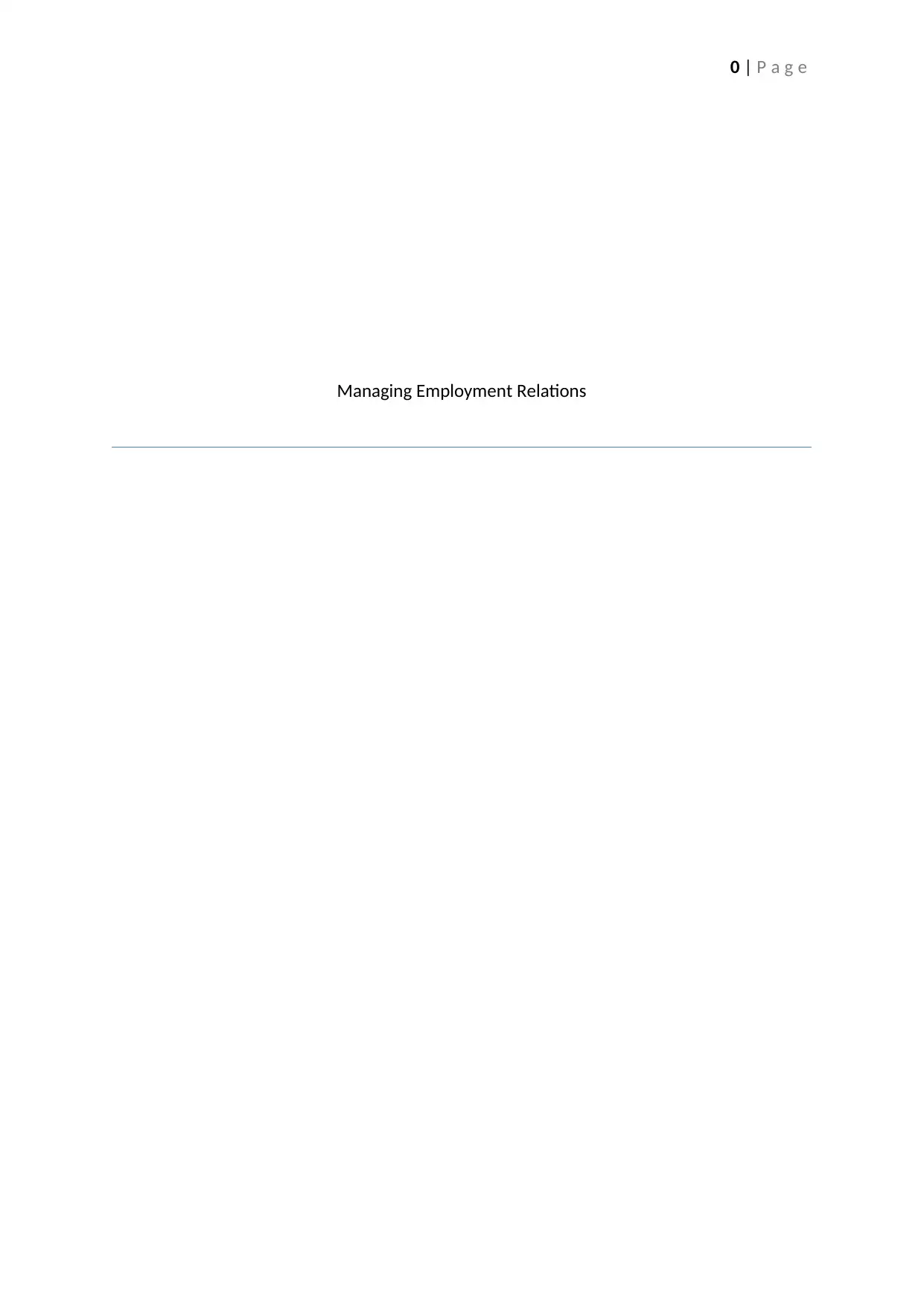
0 | P a g e
Managing Employment Relations
Managing Employment Relations
Paraphrase This Document
Need a fresh take? Get an instant paraphrase of this document with our AI Paraphraser
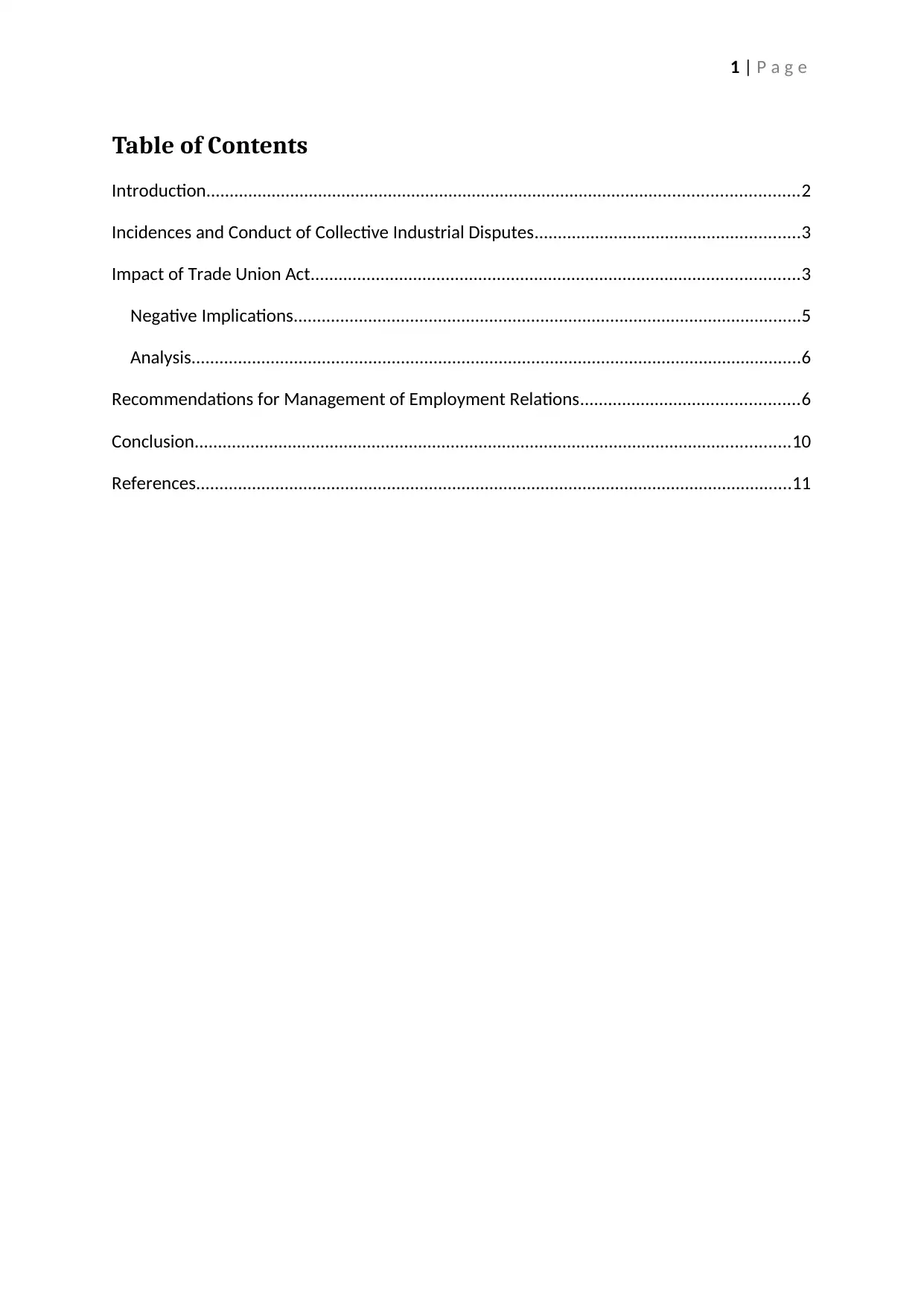
1 | P a g e
Table of Contents
Introduction...............................................................................................................................2
Incidences and Conduct of Collective Industrial Disputes.........................................................3
Impact of Trade Union Act.........................................................................................................3
Negative Implications.............................................................................................................5
Analysis...................................................................................................................................6
Recommendations for Management of Employment Relations...............................................6
Conclusion................................................................................................................................10
References................................................................................................................................11
Table of Contents
Introduction...............................................................................................................................2
Incidences and Conduct of Collective Industrial Disputes.........................................................3
Impact of Trade Union Act.........................................................................................................3
Negative Implications.............................................................................................................5
Analysis...................................................................................................................................6
Recommendations for Management of Employment Relations...............................................6
Conclusion................................................................................................................................10
References................................................................................................................................11
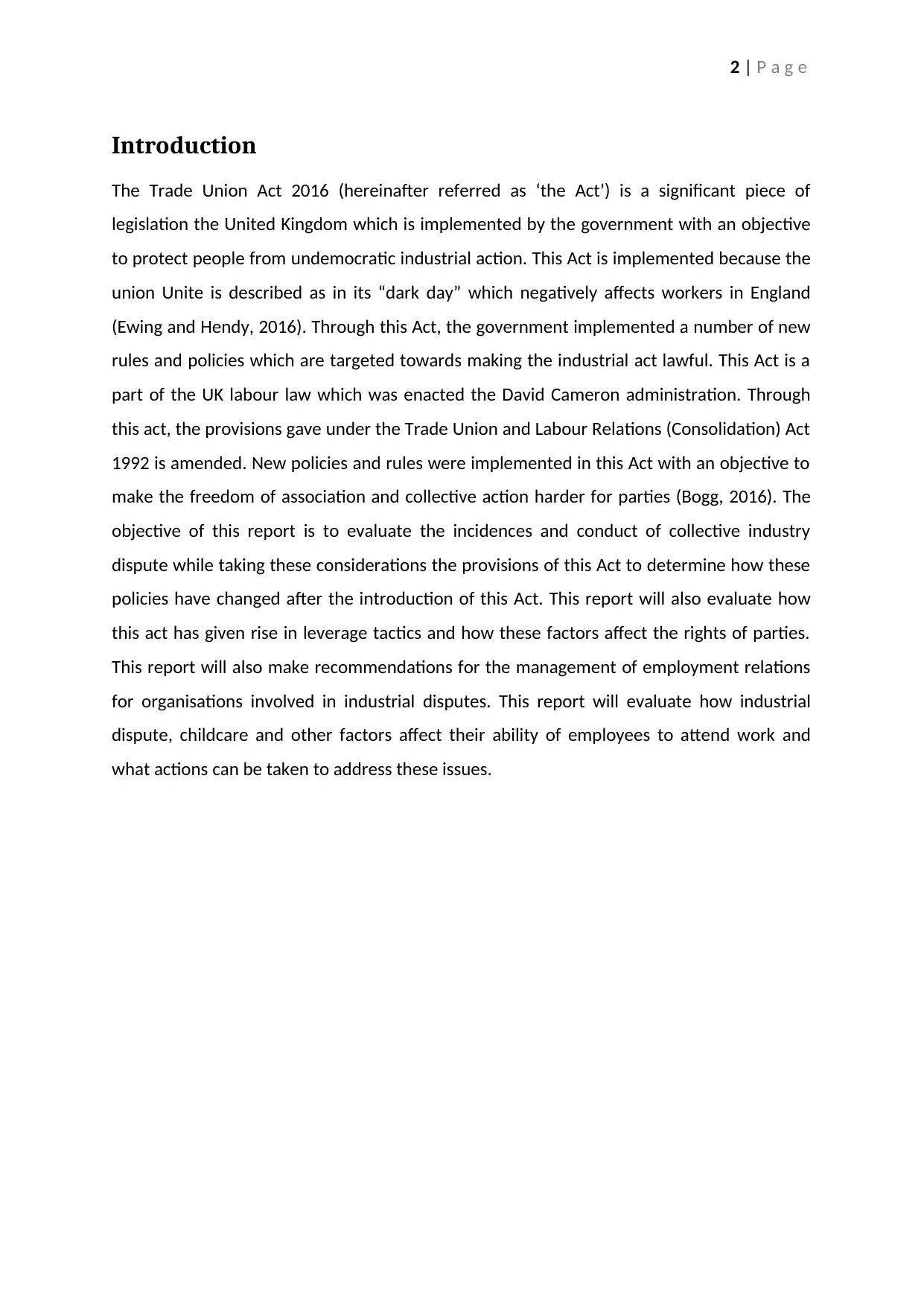
2 | P a g e
Introduction
The Trade Union Act 2016 (hereinafter referred as ‘the Act’) is a significant piece of
legislation the United Kingdom which is implemented by the government with an objective
to protect people from undemocratic industrial action. This Act is implemented because the
union Unite is described as in its “dark day” which negatively affects workers in England
(Ewing and Hendy, 2016). Through this Act, the government implemented a number of new
rules and policies which are targeted towards making the industrial act lawful. This Act is a
part of the UK labour law which was enacted the David Cameron administration. Through
this act, the provisions gave under the Trade Union and Labour Relations (Consolidation) Act
1992 is amended. New policies and rules were implemented in this Act with an objective to
make the freedom of association and collective action harder for parties (Bogg, 2016). The
objective of this report is to evaluate the incidences and conduct of collective industry
dispute while taking these considerations the provisions of this Act to determine how these
policies have changed after the introduction of this Act. This report will also evaluate how
this act has given rise in leverage tactics and how these factors affect the rights of parties.
This report will also make recommendations for the management of employment relations
for organisations involved in industrial disputes. This report will evaluate how industrial
dispute, childcare and other factors affect their ability of employees to attend work and
what actions can be taken to address these issues.
Introduction
The Trade Union Act 2016 (hereinafter referred as ‘the Act’) is a significant piece of
legislation the United Kingdom which is implemented by the government with an objective
to protect people from undemocratic industrial action. This Act is implemented because the
union Unite is described as in its “dark day” which negatively affects workers in England
(Ewing and Hendy, 2016). Through this Act, the government implemented a number of new
rules and policies which are targeted towards making the industrial act lawful. This Act is a
part of the UK labour law which was enacted the David Cameron administration. Through
this act, the provisions gave under the Trade Union and Labour Relations (Consolidation) Act
1992 is amended. New policies and rules were implemented in this Act with an objective to
make the freedom of association and collective action harder for parties (Bogg, 2016). The
objective of this report is to evaluate the incidences and conduct of collective industry
dispute while taking these considerations the provisions of this Act to determine how these
policies have changed after the introduction of this Act. This report will also evaluate how
this act has given rise in leverage tactics and how these factors affect the rights of parties.
This report will also make recommendations for the management of employment relations
for organisations involved in industrial disputes. This report will evaluate how industrial
dispute, childcare and other factors affect their ability of employees to attend work and
what actions can be taken to address these issues.
⊘ This is a preview!⊘
Do you want full access?
Subscribe today to unlock all pages.

Trusted by 1+ million students worldwide
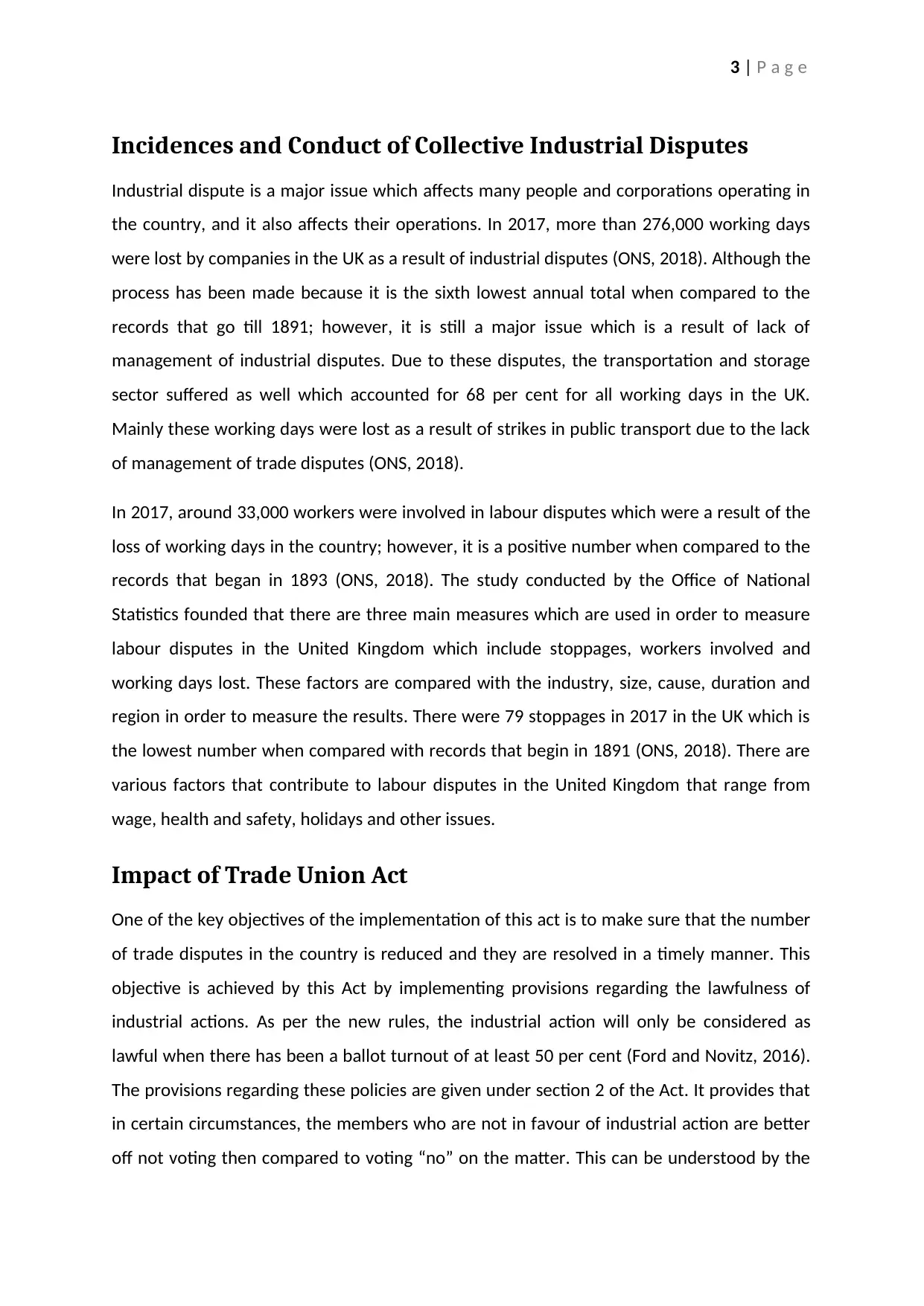
3 | P a g e
Incidences and Conduct of Collective Industrial Disputes
Industrial dispute is a major issue which affects many people and corporations operating in
the country, and it also affects their operations. In 2017, more than 276,000 working days
were lost by companies in the UK as a result of industrial disputes (ONS, 2018). Although the
process has been made because it is the sixth lowest annual total when compared to the
records that go till 1891; however, it is still a major issue which is a result of lack of
management of industrial disputes. Due to these disputes, the transportation and storage
sector suffered as well which accounted for 68 per cent for all working days in the UK.
Mainly these working days were lost as a result of strikes in public transport due to the lack
of management of trade disputes (ONS, 2018).
In 2017, around 33,000 workers were involved in labour disputes which were a result of the
loss of working days in the country; however, it is a positive number when compared to the
records that began in 1893 (ONS, 2018). The study conducted by the Office of National
Statistics founded that there are three main measures which are used in order to measure
labour disputes in the United Kingdom which include stoppages, workers involved and
working days lost. These factors are compared with the industry, size, cause, duration and
region in order to measure the results. There were 79 stoppages in 2017 in the UK which is
the lowest number when compared with records that begin in 1891 (ONS, 2018). There are
various factors that contribute to labour disputes in the United Kingdom that range from
wage, health and safety, holidays and other issues.
Impact of Trade Union Act
One of the key objectives of the implementation of this act is to make sure that the number
of trade disputes in the country is reduced and they are resolved in a timely manner. This
objective is achieved by this Act by implementing provisions regarding the lawfulness of
industrial actions. As per the new rules, the industrial action will only be considered as
lawful when there has been a ballot turnout of at least 50 per cent (Ford and Novitz, 2016).
The provisions regarding these policies are given under section 2 of the Act. It provides that
in certain circumstances, the members who are not in favour of industrial action are better
off not voting then compared to voting “no” on the matter. This can be understood by the
Incidences and Conduct of Collective Industrial Disputes
Industrial dispute is a major issue which affects many people and corporations operating in
the country, and it also affects their operations. In 2017, more than 276,000 working days
were lost by companies in the UK as a result of industrial disputes (ONS, 2018). Although the
process has been made because it is the sixth lowest annual total when compared to the
records that go till 1891; however, it is still a major issue which is a result of lack of
management of industrial disputes. Due to these disputes, the transportation and storage
sector suffered as well which accounted for 68 per cent for all working days in the UK.
Mainly these working days were lost as a result of strikes in public transport due to the lack
of management of trade disputes (ONS, 2018).
In 2017, around 33,000 workers were involved in labour disputes which were a result of the
loss of working days in the country; however, it is a positive number when compared to the
records that began in 1893 (ONS, 2018). The study conducted by the Office of National
Statistics founded that there are three main measures which are used in order to measure
labour disputes in the United Kingdom which include stoppages, workers involved and
working days lost. These factors are compared with the industry, size, cause, duration and
region in order to measure the results. There were 79 stoppages in 2017 in the UK which is
the lowest number when compared with records that begin in 1891 (ONS, 2018). There are
various factors that contribute to labour disputes in the United Kingdom that range from
wage, health and safety, holidays and other issues.
Impact of Trade Union Act
One of the key objectives of the implementation of this act is to make sure that the number
of trade disputes in the country is reduced and they are resolved in a timely manner. This
objective is achieved by this Act by implementing provisions regarding the lawfulness of
industrial actions. As per the new rules, the industrial action will only be considered as
lawful when there has been a ballot turnout of at least 50 per cent (Ford and Novitz, 2016).
The provisions regarding these policies are given under section 2 of the Act. It provides that
in certain circumstances, the members who are not in favour of industrial action are better
off not voting then compared to voting “no” on the matter. This can be understood by the
Paraphrase This Document
Need a fresh take? Get an instant paraphrase of this document with our AI Paraphraser
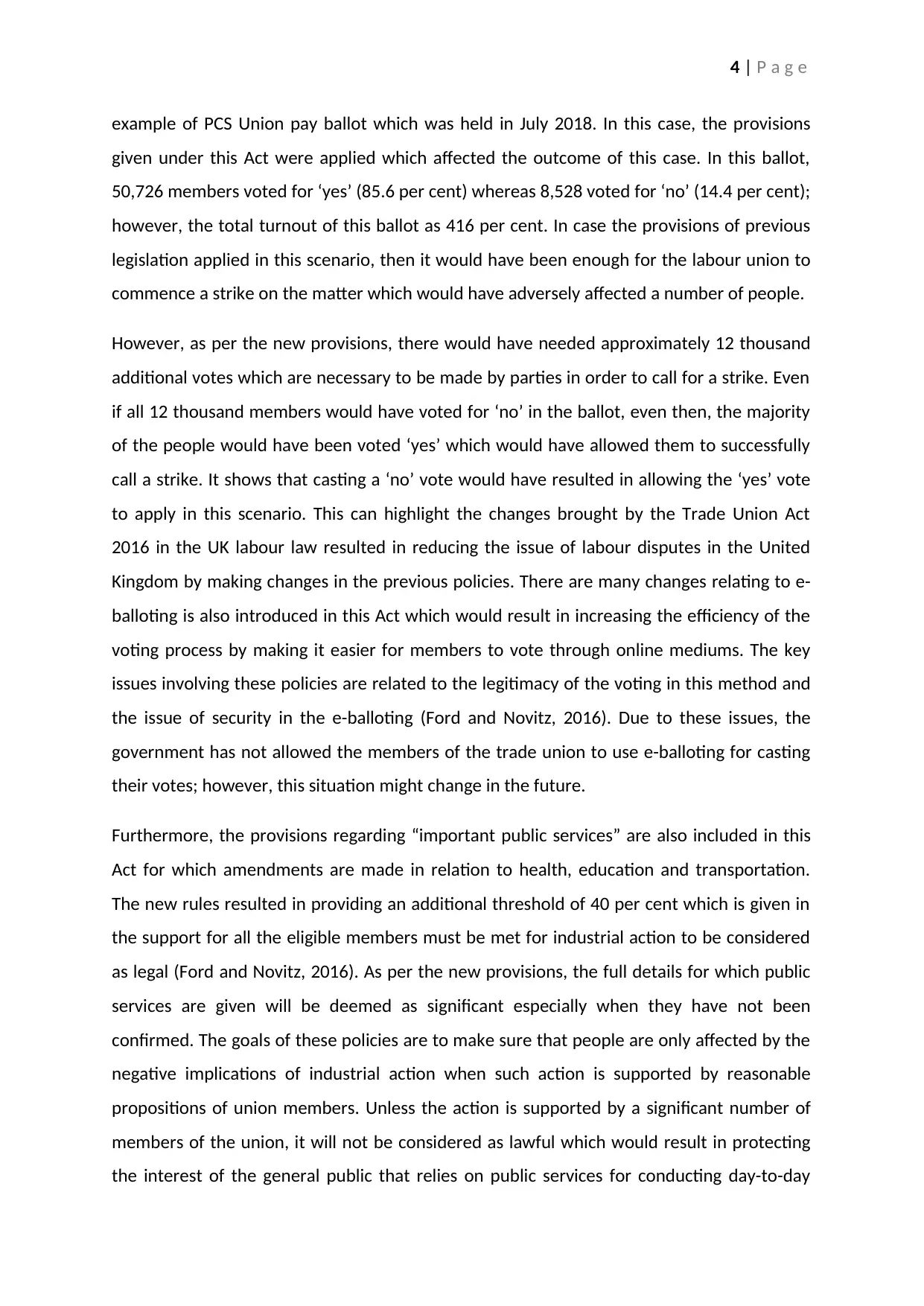
4 | P a g e
example of PCS Union pay ballot which was held in July 2018. In this case, the provisions
given under this Act were applied which affected the outcome of this case. In this ballot,
50,726 members voted for ‘yes’ (85.6 per cent) whereas 8,528 voted for ‘no’ (14.4 per cent);
however, the total turnout of this ballot as 416 per cent. In case the provisions of previous
legislation applied in this scenario, then it would have been enough for the labour union to
commence a strike on the matter which would have adversely affected a number of people.
However, as per the new provisions, there would have needed approximately 12 thousand
additional votes which are necessary to be made by parties in order to call for a strike. Even
if all 12 thousand members would have voted for ‘no’ in the ballot, even then, the majority
of the people would have been voted ‘yes’ which would have allowed them to successfully
call a strike. It shows that casting a ‘no’ vote would have resulted in allowing the ‘yes’ vote
to apply in this scenario. This can highlight the changes brought by the Trade Union Act
2016 in the UK labour law resulted in reducing the issue of labour disputes in the United
Kingdom by making changes in the previous policies. There are many changes relating to e-
balloting is also introduced in this Act which would result in increasing the efficiency of the
voting process by making it easier for members to vote through online mediums. The key
issues involving these policies are related to the legitimacy of the voting in this method and
the issue of security in the e-balloting (Ford and Novitz, 2016). Due to these issues, the
government has not allowed the members of the trade union to use e-balloting for casting
their votes; however, this situation might change in the future.
Furthermore, the provisions regarding “important public services” are also included in this
Act for which amendments are made in relation to health, education and transportation.
The new rules resulted in providing an additional threshold of 40 per cent which is given in
the support for all the eligible members must be met for industrial action to be considered
as legal (Ford and Novitz, 2016). As per the new provisions, the full details for which public
services are given will be deemed as significant especially when they have not been
confirmed. The goals of these policies are to make sure that people are only affected by the
negative implications of industrial action when such action is supported by reasonable
propositions of union members. Unless the action is supported by a significant number of
members of the union, it will not be considered as lawful which would result in protecting
the interest of the general public that relies on public services for conducting day-to-day
example of PCS Union pay ballot which was held in July 2018. In this case, the provisions
given under this Act were applied which affected the outcome of this case. In this ballot,
50,726 members voted for ‘yes’ (85.6 per cent) whereas 8,528 voted for ‘no’ (14.4 per cent);
however, the total turnout of this ballot as 416 per cent. In case the provisions of previous
legislation applied in this scenario, then it would have been enough for the labour union to
commence a strike on the matter which would have adversely affected a number of people.
However, as per the new provisions, there would have needed approximately 12 thousand
additional votes which are necessary to be made by parties in order to call for a strike. Even
if all 12 thousand members would have voted for ‘no’ in the ballot, even then, the majority
of the people would have been voted ‘yes’ which would have allowed them to successfully
call a strike. It shows that casting a ‘no’ vote would have resulted in allowing the ‘yes’ vote
to apply in this scenario. This can highlight the changes brought by the Trade Union Act
2016 in the UK labour law resulted in reducing the issue of labour disputes in the United
Kingdom by making changes in the previous policies. There are many changes relating to e-
balloting is also introduced in this Act which would result in increasing the efficiency of the
voting process by making it easier for members to vote through online mediums. The key
issues involving these policies are related to the legitimacy of the voting in this method and
the issue of security in the e-balloting (Ford and Novitz, 2016). Due to these issues, the
government has not allowed the members of the trade union to use e-balloting for casting
their votes; however, this situation might change in the future.
Furthermore, the provisions regarding “important public services” are also included in this
Act for which amendments are made in relation to health, education and transportation.
The new rules resulted in providing an additional threshold of 40 per cent which is given in
the support for all the eligible members must be met for industrial action to be considered
as legal (Ford and Novitz, 2016). As per the new provisions, the full details for which public
services are given will be deemed as significant especially when they have not been
confirmed. The goals of these policies are to make sure that people are only affected by the
negative implications of industrial action when such action is supported by reasonable
propositions of union members. Unless the action is supported by a significant number of
members of the union, it will not be considered as lawful which would result in protecting
the interest of the general public that relies on public services for conducting day-to-day
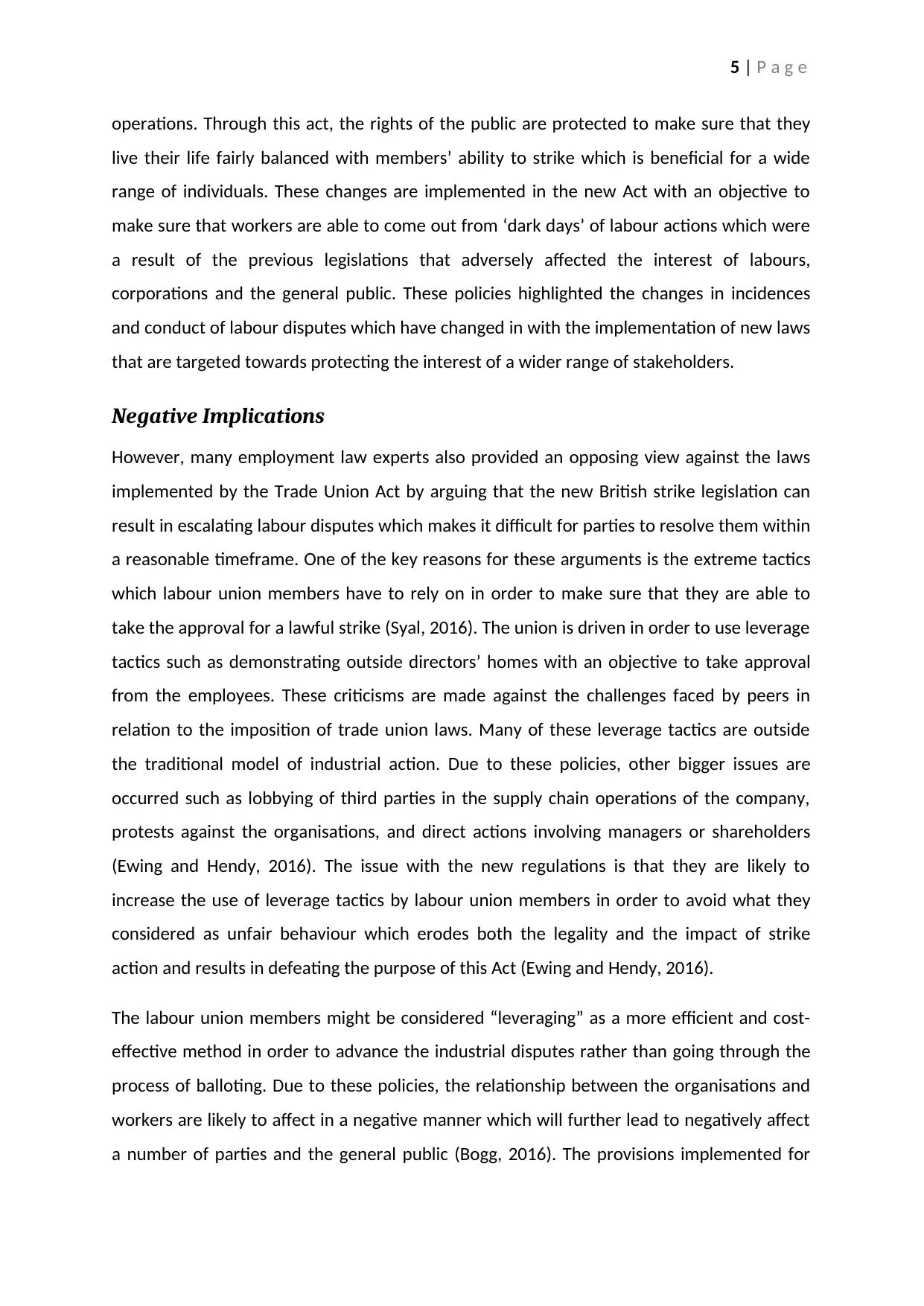
5 | P a g e
operations. Through this act, the rights of the public are protected to make sure that they
live their life fairly balanced with members’ ability to strike which is beneficial for a wide
range of individuals. These changes are implemented in the new Act with an objective to
make sure that workers are able to come out from ‘dark days’ of labour actions which were
a result of the previous legislations that adversely affected the interest of labours,
corporations and the general public. These policies highlighted the changes in incidences
and conduct of labour disputes which have changed in with the implementation of new laws
that are targeted towards protecting the interest of a wider range of stakeholders.
Negative Implications
However, many employment law experts also provided an opposing view against the laws
implemented by the Trade Union Act by arguing that the new British strike legislation can
result in escalating labour disputes which makes it difficult for parties to resolve them within
a reasonable timeframe. One of the key reasons for these arguments is the extreme tactics
which labour union members have to rely on in order to make sure that they are able to
take the approval for a lawful strike (Syal, 2016). The union is driven in order to use leverage
tactics such as demonstrating outside directors’ homes with an objective to take approval
from the employees. These criticisms are made against the challenges faced by peers in
relation to the imposition of trade union laws. Many of these leverage tactics are outside
the traditional model of industrial action. Due to these policies, other bigger issues are
occurred such as lobbying of third parties in the supply chain operations of the company,
protests against the organisations, and direct actions involving managers or shareholders
(Ewing and Hendy, 2016). The issue with the new regulations is that they are likely to
increase the use of leverage tactics by labour union members in order to avoid what they
considered as unfair behaviour which erodes both the legality and the impact of strike
action and results in defeating the purpose of this Act (Ewing and Hendy, 2016).
The labour union members might be considered “leveraging” as a more efficient and cost-
effective method in order to advance the industrial disputes rather than going through the
process of balloting. Due to these policies, the relationship between the organisations and
workers are likely to affect in a negative manner which will further lead to negatively affect
a number of parties and the general public (Bogg, 2016). The provisions implemented for
operations. Through this act, the rights of the public are protected to make sure that they
live their life fairly balanced with members’ ability to strike which is beneficial for a wide
range of individuals. These changes are implemented in the new Act with an objective to
make sure that workers are able to come out from ‘dark days’ of labour actions which were
a result of the previous legislations that adversely affected the interest of labours,
corporations and the general public. These policies highlighted the changes in incidences
and conduct of labour disputes which have changed in with the implementation of new laws
that are targeted towards protecting the interest of a wider range of stakeholders.
Negative Implications
However, many employment law experts also provided an opposing view against the laws
implemented by the Trade Union Act by arguing that the new British strike legislation can
result in escalating labour disputes which makes it difficult for parties to resolve them within
a reasonable timeframe. One of the key reasons for these arguments is the extreme tactics
which labour union members have to rely on in order to make sure that they are able to
take the approval for a lawful strike (Syal, 2016). The union is driven in order to use leverage
tactics such as demonstrating outside directors’ homes with an objective to take approval
from the employees. These criticisms are made against the challenges faced by peers in
relation to the imposition of trade union laws. Many of these leverage tactics are outside
the traditional model of industrial action. Due to these policies, other bigger issues are
occurred such as lobbying of third parties in the supply chain operations of the company,
protests against the organisations, and direct actions involving managers or shareholders
(Ewing and Hendy, 2016). The issue with the new regulations is that they are likely to
increase the use of leverage tactics by labour union members in order to avoid what they
considered as unfair behaviour which erodes both the legality and the impact of strike
action and results in defeating the purpose of this Act (Ewing and Hendy, 2016).
The labour union members might be considered “leveraging” as a more efficient and cost-
effective method in order to advance the industrial disputes rather than going through the
process of balloting. Due to these policies, the relationship between the organisations and
workers are likely to affect in a negative manner which will further lead to negatively affect
a number of parties and the general public (Bogg, 2016). The provisions implemented for
⊘ This is a preview!⊘
Do you want full access?
Subscribe today to unlock all pages.

Trusted by 1+ million students worldwide
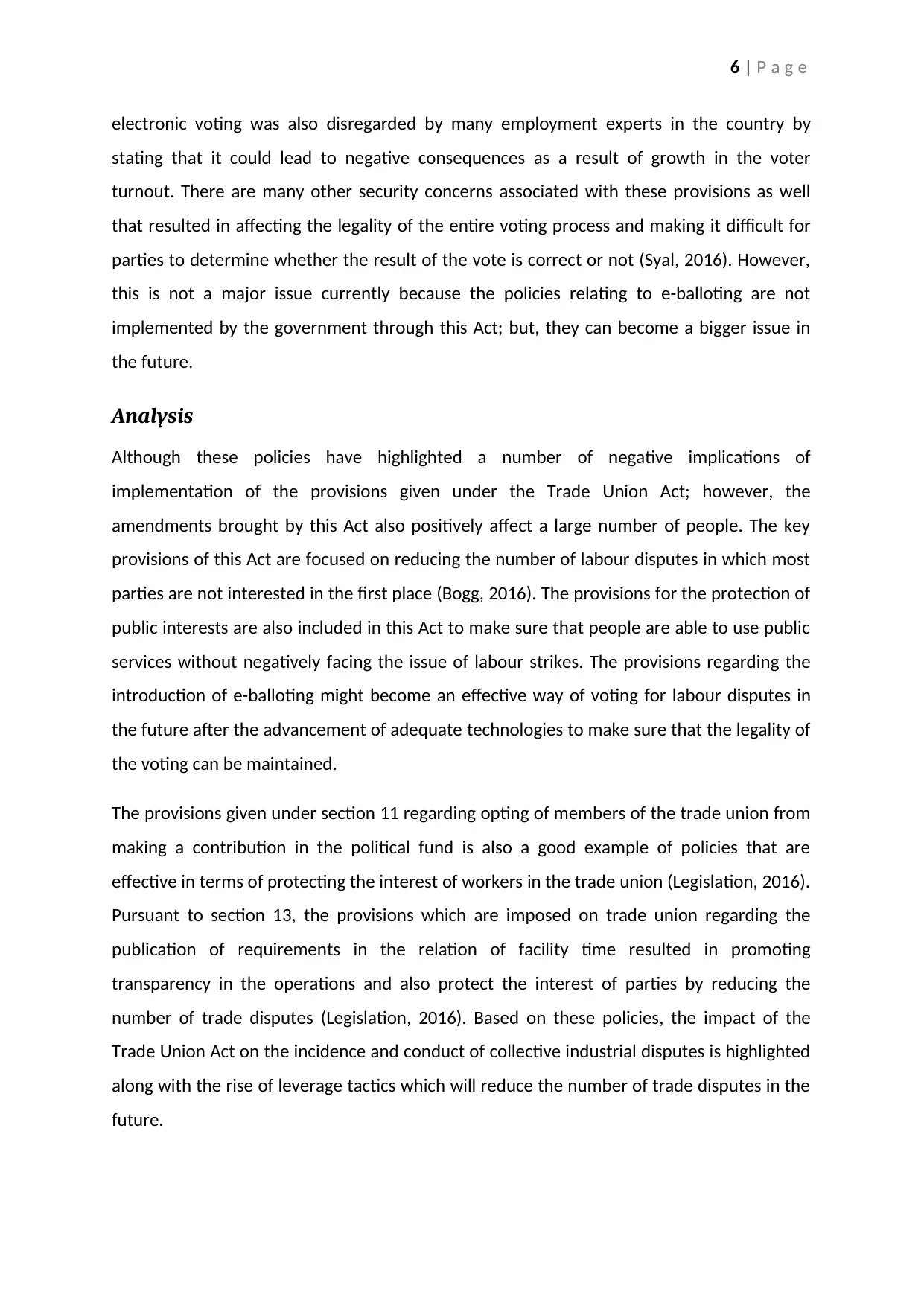
6 | P a g e
electronic voting was also disregarded by many employment experts in the country by
stating that it could lead to negative consequences as a result of growth in the voter
turnout. There are many other security concerns associated with these provisions as well
that resulted in affecting the legality of the entire voting process and making it difficult for
parties to determine whether the result of the vote is correct or not (Syal, 2016). However,
this is not a major issue currently because the policies relating to e-balloting are not
implemented by the government through this Act; but, they can become a bigger issue in
the future.
Analysis
Although these policies have highlighted a number of negative implications of
implementation of the provisions given under the Trade Union Act; however, the
amendments brought by this Act also positively affect a large number of people. The key
provisions of this Act are focused on reducing the number of labour disputes in which most
parties are not interested in the first place (Bogg, 2016). The provisions for the protection of
public interests are also included in this Act to make sure that people are able to use public
services without negatively facing the issue of labour strikes. The provisions regarding the
introduction of e-balloting might become an effective way of voting for labour disputes in
the future after the advancement of adequate technologies to make sure that the legality of
the voting can be maintained.
The provisions given under section 11 regarding opting of members of the trade union from
making a contribution in the political fund is also a good example of policies that are
effective in terms of protecting the interest of workers in the trade union (Legislation, 2016).
Pursuant to section 13, the provisions which are imposed on trade union regarding the
publication of requirements in the relation of facility time resulted in promoting
transparency in the operations and also protect the interest of parties by reducing the
number of trade disputes (Legislation, 2016). Based on these policies, the impact of the
Trade Union Act on the incidence and conduct of collective industrial disputes is highlighted
along with the rise of leverage tactics which will reduce the number of trade disputes in the
future.
electronic voting was also disregarded by many employment experts in the country by
stating that it could lead to negative consequences as a result of growth in the voter
turnout. There are many other security concerns associated with these provisions as well
that resulted in affecting the legality of the entire voting process and making it difficult for
parties to determine whether the result of the vote is correct or not (Syal, 2016). However,
this is not a major issue currently because the policies relating to e-balloting are not
implemented by the government through this Act; but, they can become a bigger issue in
the future.
Analysis
Although these policies have highlighted a number of negative implications of
implementation of the provisions given under the Trade Union Act; however, the
amendments brought by this Act also positively affect a large number of people. The key
provisions of this Act are focused on reducing the number of labour disputes in which most
parties are not interested in the first place (Bogg, 2016). The provisions for the protection of
public interests are also included in this Act to make sure that people are able to use public
services without negatively facing the issue of labour strikes. The provisions regarding the
introduction of e-balloting might become an effective way of voting for labour disputes in
the future after the advancement of adequate technologies to make sure that the legality of
the voting can be maintained.
The provisions given under section 11 regarding opting of members of the trade union from
making a contribution in the political fund is also a good example of policies that are
effective in terms of protecting the interest of workers in the trade union (Legislation, 2016).
Pursuant to section 13, the provisions which are imposed on trade union regarding the
publication of requirements in the relation of facility time resulted in promoting
transparency in the operations and also protect the interest of parties by reducing the
number of trade disputes (Legislation, 2016). Based on these policies, the impact of the
Trade Union Act on the incidence and conduct of collective industrial disputes is highlighted
along with the rise of leverage tactics which will reduce the number of trade disputes in the
future.
Paraphrase This Document
Need a fresh take? Get an instant paraphrase of this document with our AI Paraphraser
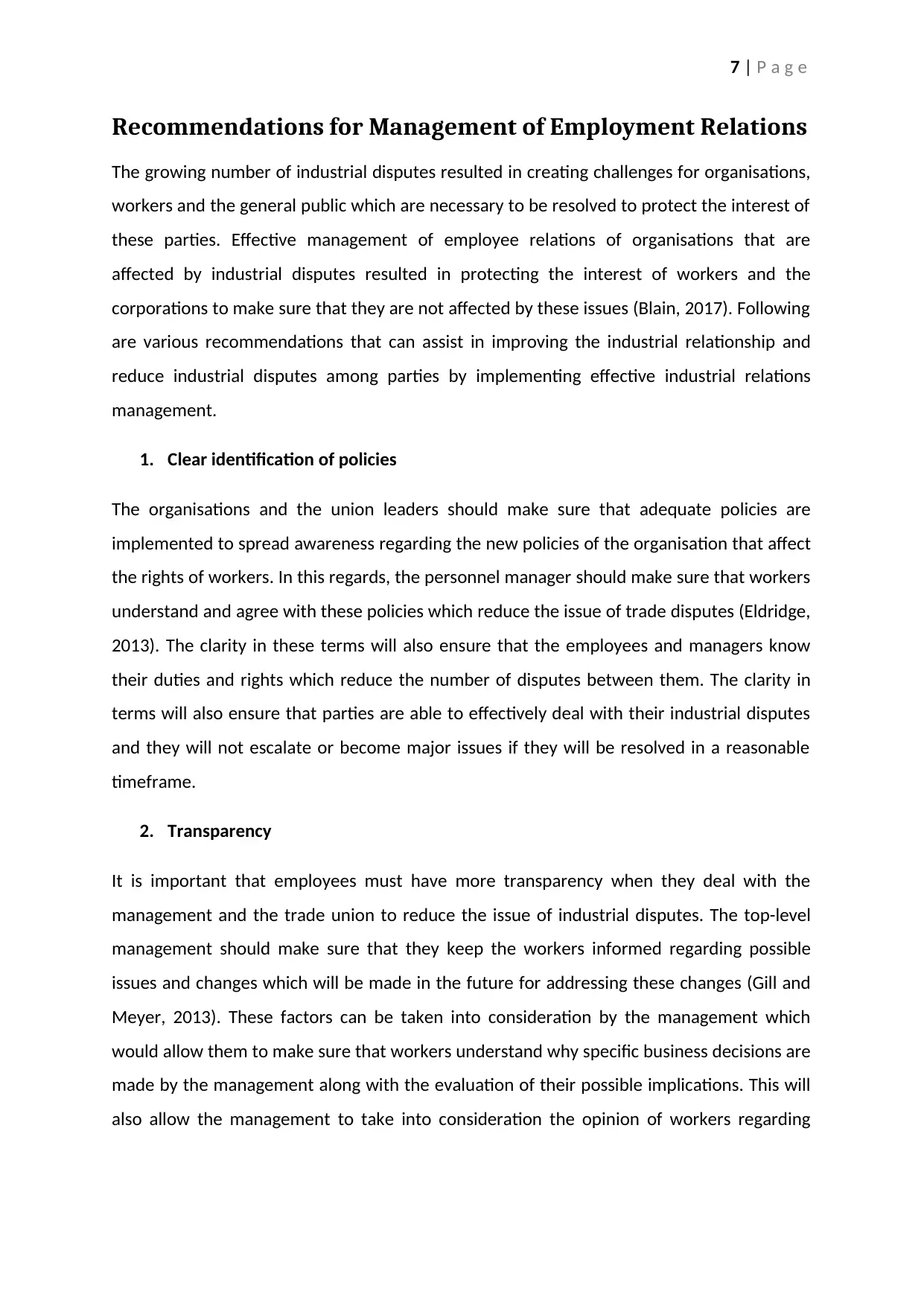
7 | P a g e
Recommendations for Management of Employment Relations
The growing number of industrial disputes resulted in creating challenges for organisations,
workers and the general public which are necessary to be resolved to protect the interest of
these parties. Effective management of employee relations of organisations that are
affected by industrial disputes resulted in protecting the interest of workers and the
corporations to make sure that they are not affected by these issues (Blain, 2017). Following
are various recommendations that can assist in improving the industrial relationship and
reduce industrial disputes among parties by implementing effective industrial relations
management.
1. Clear identification of policies
The organisations and the union leaders should make sure that adequate policies are
implemented to spread awareness regarding the new policies of the organisation that affect
the rights of workers. In this regards, the personnel manager should make sure that workers
understand and agree with these policies which reduce the issue of trade disputes (Eldridge,
2013). The clarity in these terms will also ensure that the employees and managers know
their duties and rights which reduce the number of disputes between them. The clarity in
terms will also ensure that parties are able to effectively deal with their industrial disputes
and they will not escalate or become major issues if they will be resolved in a reasonable
timeframe.
2. Transparency
It is important that employees must have more transparency when they deal with the
management and the trade union to reduce the issue of industrial disputes. The top-level
management should make sure that they keep the workers informed regarding possible
issues and changes which will be made in the future for addressing these changes (Gill and
Meyer, 2013). These factors can be taken into consideration by the management which
would allow them to make sure that workers understand why specific business decisions are
made by the management along with the evaluation of their possible implications. This will
also allow the management to take into consideration the opinion of workers regarding
Recommendations for Management of Employment Relations
The growing number of industrial disputes resulted in creating challenges for organisations,
workers and the general public which are necessary to be resolved to protect the interest of
these parties. Effective management of employee relations of organisations that are
affected by industrial disputes resulted in protecting the interest of workers and the
corporations to make sure that they are not affected by these issues (Blain, 2017). Following
are various recommendations that can assist in improving the industrial relationship and
reduce industrial disputes among parties by implementing effective industrial relations
management.
1. Clear identification of policies
The organisations and the union leaders should make sure that adequate policies are
implemented to spread awareness regarding the new policies of the organisation that affect
the rights of workers. In this regards, the personnel manager should make sure that workers
understand and agree with these policies which reduce the issue of trade disputes (Eldridge,
2013). The clarity in these terms will also ensure that the employees and managers know
their duties and rights which reduce the number of disputes between them. The clarity in
terms will also ensure that parties are able to effectively deal with their industrial disputes
and they will not escalate or become major issues if they will be resolved in a reasonable
timeframe.
2. Transparency
It is important that employees must have more transparency when they deal with the
management and the trade union to reduce the issue of industrial disputes. The top-level
management should make sure that they keep the workers informed regarding possible
issues and changes which will be made in the future for addressing these changes (Gill and
Meyer, 2013). These factors can be taken into consideration by the management which
would allow them to make sure that workers understand why specific business decisions are
made by the management along with the evaluation of their possible implications. This will
also allow the management to take into consideration the opinion of workers regarding

8 | P a g e
organisations policies which is crucial to reduce industrial disputes in the organisation that
will reduce the negative impact.
3. Opportunities to quickly resolve issues
During industrial disputes, the workers who wanted to work are not able to go to work due
to employee strikes and trade disputes among the members. These factors also create
challenges for the employees by making it difficult for them to earn a living by doing their
work. Thus, the management should focus on resolving these issues in a quick manner to
make sure that workers are able to go to work and earn a living and they are not affected by
the negative consequences of the labour dispute (Barry and Wilkinson, 2016). The
corporations should also ensure that there are adequate childcare facilities given to the
workers which allow them to discharge their duties without being distracted regarding the
welfare of their children.
4. Taking advantage of feedback
The corporations can rely on feedback of employees to manage industrial disputes since it is
highly beneficial for maintaining the inner working of the organisation. During the decision-
making process, the management can rely on the feedback of workers to understand the
necessary changes and policies which they expect from the organisation. After the
implementation of these policies, the management can also rely on the feedback to collect
relevant data regarding the opinions of the employees to make sure that they are able to
express their views (Molina, 2014). This will promote two-way communication channels
between the management and employees to make sure that the issue of industrial dispute
can be resolved in a reasonable timeframe by communicating to find a potential middle
ground for the parties.
5. Cooperation is Key
In order to effectively manage industrial disputes, the organisations should rely on
cooperation which is the key when it comes to addressing these issues. Employees should
understand that they are not competitors and cooperation allows them to achieve greater
results which are beneficial for the company and themselves. There should be cooperation
between the workers and the management to make sure that understand each other (Blain,
organisations policies which is crucial to reduce industrial disputes in the organisation that
will reduce the negative impact.
3. Opportunities to quickly resolve issues
During industrial disputes, the workers who wanted to work are not able to go to work due
to employee strikes and trade disputes among the members. These factors also create
challenges for the employees by making it difficult for them to earn a living by doing their
work. Thus, the management should focus on resolving these issues in a quick manner to
make sure that workers are able to go to work and earn a living and they are not affected by
the negative consequences of the labour dispute (Barry and Wilkinson, 2016). The
corporations should also ensure that there are adequate childcare facilities given to the
workers which allow them to discharge their duties without being distracted regarding the
welfare of their children.
4. Taking advantage of feedback
The corporations can rely on feedback of employees to manage industrial disputes since it is
highly beneficial for maintaining the inner working of the organisation. During the decision-
making process, the management can rely on the feedback of workers to understand the
necessary changes and policies which they expect from the organisation. After the
implementation of these policies, the management can also rely on the feedback to collect
relevant data regarding the opinions of the employees to make sure that they are able to
express their views (Molina, 2014). This will promote two-way communication channels
between the management and employees to make sure that the issue of industrial dispute
can be resolved in a reasonable timeframe by communicating to find a potential middle
ground for the parties.
5. Cooperation is Key
In order to effectively manage industrial disputes, the organisations should rely on
cooperation which is the key when it comes to addressing these issues. Employees should
understand that they are not competitors and cooperation allows them to achieve greater
results which are beneficial for the company and themselves. There should be cooperation
between the workers and the management to make sure that understand each other (Blain,
⊘ This is a preview!⊘
Do you want full access?
Subscribe today to unlock all pages.

Trusted by 1+ million students worldwide
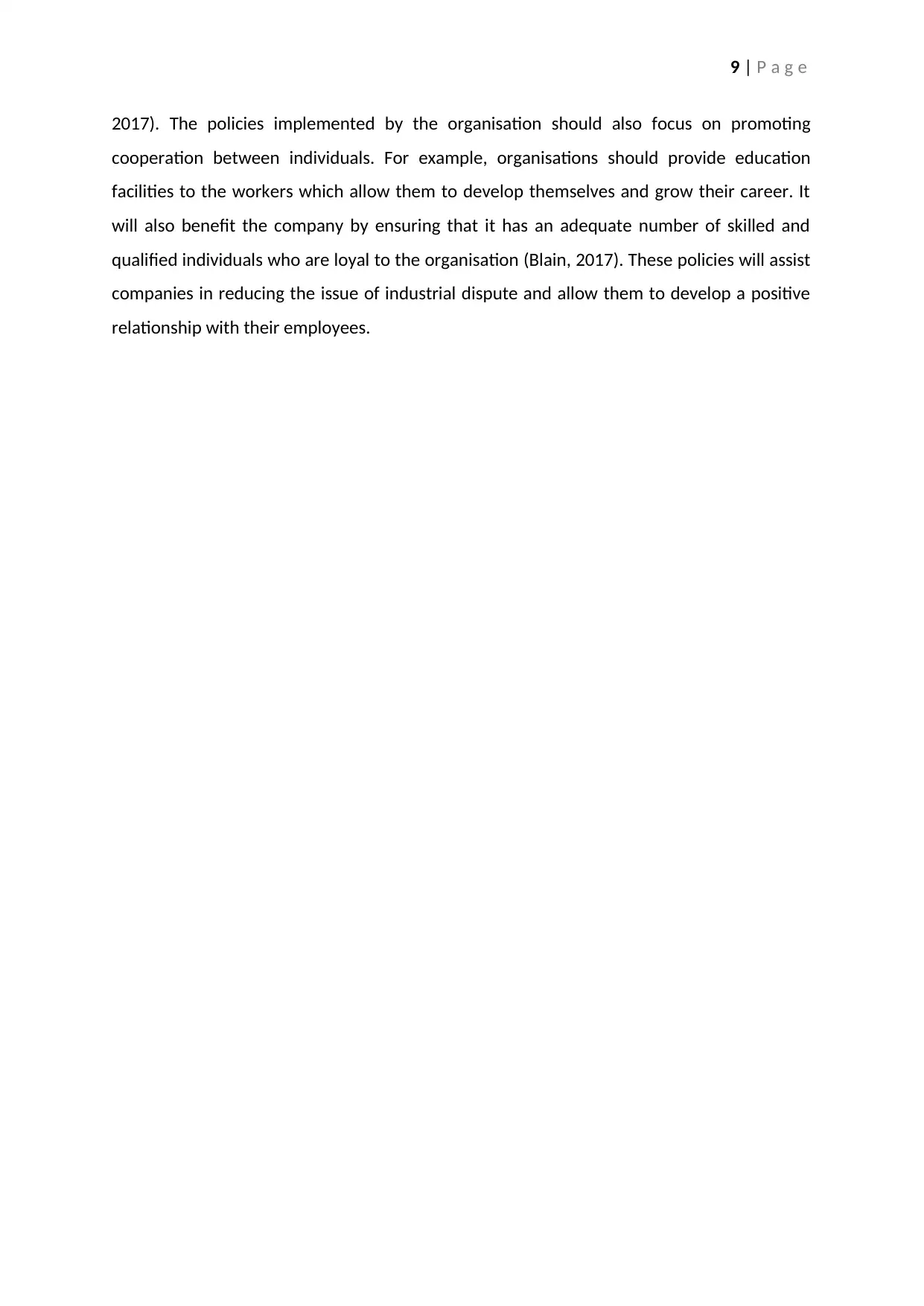
9 | P a g e
2017). The policies implemented by the organisation should also focus on promoting
cooperation between individuals. For example, organisations should provide education
facilities to the workers which allow them to develop themselves and grow their career. It
will also benefit the company by ensuring that it has an adequate number of skilled and
qualified individuals who are loyal to the organisation (Blain, 2017). These policies will assist
companies in reducing the issue of industrial dispute and allow them to develop a positive
relationship with their employees.
2017). The policies implemented by the organisation should also focus on promoting
cooperation between individuals. For example, organisations should provide education
facilities to the workers which allow them to develop themselves and grow their career. It
will also benefit the company by ensuring that it has an adequate number of skilled and
qualified individuals who are loyal to the organisation (Blain, 2017). These policies will assist
companies in reducing the issue of industrial dispute and allow them to develop a positive
relationship with their employees.
Paraphrase This Document
Need a fresh take? Get an instant paraphrase of this document with our AI Paraphraser
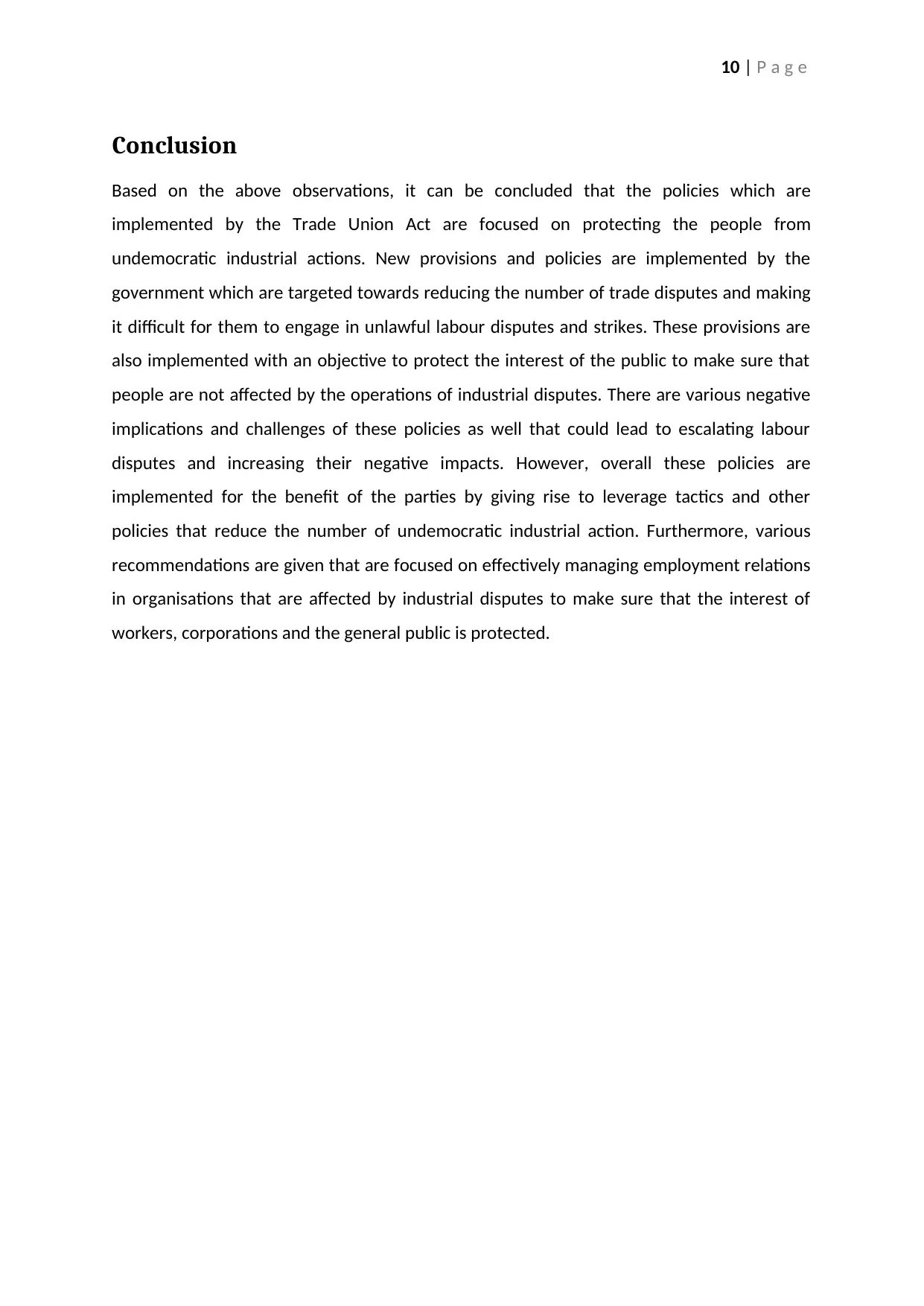
10 | P a g e
Conclusion
Based on the above observations, it can be concluded that the policies which are
implemented by the Trade Union Act are focused on protecting the people from
undemocratic industrial actions. New provisions and policies are implemented by the
government which are targeted towards reducing the number of trade disputes and making
it difficult for them to engage in unlawful labour disputes and strikes. These provisions are
also implemented with an objective to protect the interest of the public to make sure that
people are not affected by the operations of industrial disputes. There are various negative
implications and challenges of these policies as well that could lead to escalating labour
disputes and increasing their negative impacts. However, overall these policies are
implemented for the benefit of the parties by giving rise to leverage tactics and other
policies that reduce the number of undemocratic industrial action. Furthermore, various
recommendations are given that are focused on effectively managing employment relations
in organisations that are affected by industrial disputes to make sure that the interest of
workers, corporations and the general public is protected.
Conclusion
Based on the above observations, it can be concluded that the policies which are
implemented by the Trade Union Act are focused on protecting the people from
undemocratic industrial actions. New provisions and policies are implemented by the
government which are targeted towards reducing the number of trade disputes and making
it difficult for them to engage in unlawful labour disputes and strikes. These provisions are
also implemented with an objective to protect the interest of the public to make sure that
people are not affected by the operations of industrial disputes. There are various negative
implications and challenges of these policies as well that could lead to escalating labour
disputes and increasing their negative impacts. However, overall these policies are
implemented for the benefit of the parties by giving rise to leverage tactics and other
policies that reduce the number of undemocratic industrial action. Furthermore, various
recommendations are given that are focused on effectively managing employment relations
in organisations that are affected by industrial disputes to make sure that the interest of
workers, corporations and the general public is protected.
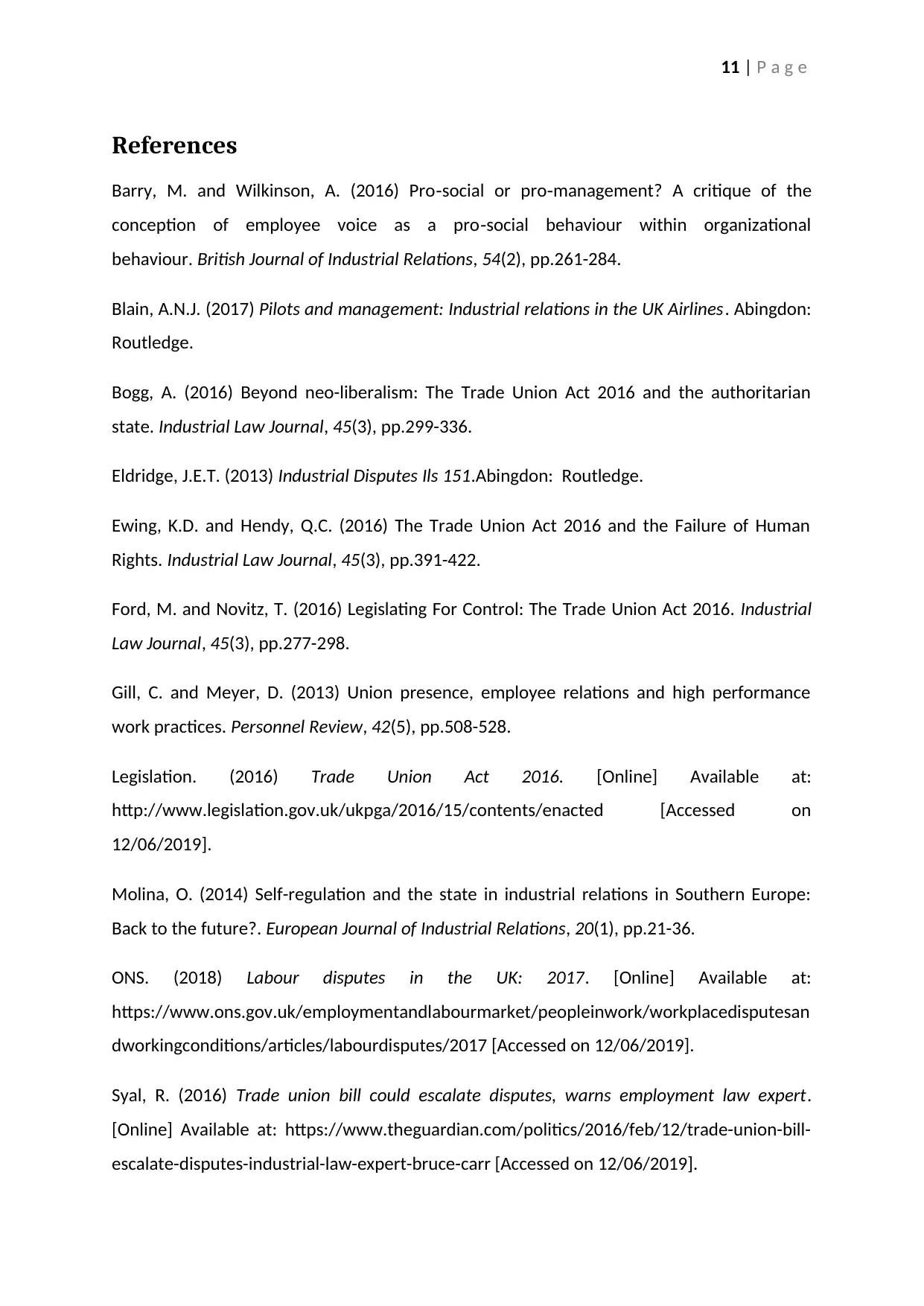
11 | P a g e
References
Barry, M. and Wilkinson, A. (2016) Pro‐social or pro‐management? A critique of the
conception of employee voice as a pro‐social behaviour within organizational
behaviour. British Journal of Industrial Relations, 54(2), pp.261-284.
Blain, A.N.J. (2017) Pilots and management: Industrial relations in the UK Airlines. Abingdon:
Routledge.
Bogg, A. (2016) Beyond neo-liberalism: The Trade Union Act 2016 and the authoritarian
state. Industrial Law Journal, 45(3), pp.299-336.
Eldridge, J.E.T. (2013) Industrial Disputes Ils 151.Abingdon: Routledge.
Ewing, K.D. and Hendy, Q.C. (2016) The Trade Union Act 2016 and the Failure of Human
Rights. Industrial Law Journal, 45(3), pp.391-422.
Ford, M. and Novitz, T. (2016) Legislating For Control: The Trade Union Act 2016. Industrial
Law Journal, 45(3), pp.277-298.
Gill, C. and Meyer, D. (2013) Union presence, employee relations and high performance
work practices. Personnel Review, 42(5), pp.508-528.
Legislation. (2016) Trade Union Act 2016. [Online] Available at:
http://www.legislation.gov.uk/ukpga/2016/15/contents/enacted [Accessed on
12/06/2019].
Molina, O. (2014) Self-regulation and the state in industrial relations in Southern Europe:
Back to the future?. European Journal of Industrial Relations, 20(1), pp.21-36.
ONS. (2018) Labour disputes in the UK: 2017. [Online] Available at:
https://www.ons.gov.uk/employmentandlabourmarket/peopleinwork/workplacedisputesan
dworkingconditions/articles/labourdisputes/2017 [Accessed on 12/06/2019].
Syal, R. (2016) Trade union bill could escalate disputes, warns employment law expert.
[Online] Available at: https://www.theguardian.com/politics/2016/feb/12/trade-union-bill-
escalate-disputes-industrial-law-expert-bruce-carr [Accessed on 12/06/2019].
References
Barry, M. and Wilkinson, A. (2016) Pro‐social or pro‐management? A critique of the
conception of employee voice as a pro‐social behaviour within organizational
behaviour. British Journal of Industrial Relations, 54(2), pp.261-284.
Blain, A.N.J. (2017) Pilots and management: Industrial relations in the UK Airlines. Abingdon:
Routledge.
Bogg, A. (2016) Beyond neo-liberalism: The Trade Union Act 2016 and the authoritarian
state. Industrial Law Journal, 45(3), pp.299-336.
Eldridge, J.E.T. (2013) Industrial Disputes Ils 151.Abingdon: Routledge.
Ewing, K.D. and Hendy, Q.C. (2016) The Trade Union Act 2016 and the Failure of Human
Rights. Industrial Law Journal, 45(3), pp.391-422.
Ford, M. and Novitz, T. (2016) Legislating For Control: The Trade Union Act 2016. Industrial
Law Journal, 45(3), pp.277-298.
Gill, C. and Meyer, D. (2013) Union presence, employee relations and high performance
work practices. Personnel Review, 42(5), pp.508-528.
Legislation. (2016) Trade Union Act 2016. [Online] Available at:
http://www.legislation.gov.uk/ukpga/2016/15/contents/enacted [Accessed on
12/06/2019].
Molina, O. (2014) Self-regulation and the state in industrial relations in Southern Europe:
Back to the future?. European Journal of Industrial Relations, 20(1), pp.21-36.
ONS. (2018) Labour disputes in the UK: 2017. [Online] Available at:
https://www.ons.gov.uk/employmentandlabourmarket/peopleinwork/workplacedisputesan
dworkingconditions/articles/labourdisputes/2017 [Accessed on 12/06/2019].
Syal, R. (2016) Trade union bill could escalate disputes, warns employment law expert.
[Online] Available at: https://www.theguardian.com/politics/2016/feb/12/trade-union-bill-
escalate-disputes-industrial-law-expert-bruce-carr [Accessed on 12/06/2019].
⊘ This is a preview!⊘
Do you want full access?
Subscribe today to unlock all pages.

Trusted by 1+ million students worldwide
1 out of 12
Related Documents
Your All-in-One AI-Powered Toolkit for Academic Success.
+13062052269
info@desklib.com
Available 24*7 on WhatsApp / Email
![[object Object]](/_next/static/media/star-bottom.7253800d.svg)
Unlock your academic potential
Copyright © 2020–2025 A2Z Services. All Rights Reserved. Developed and managed by ZUCOL.




